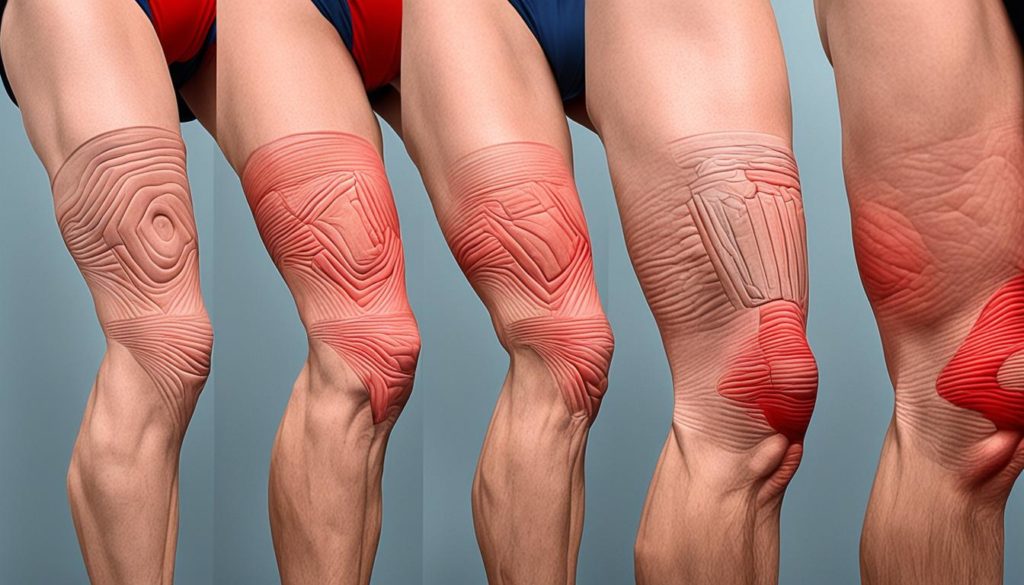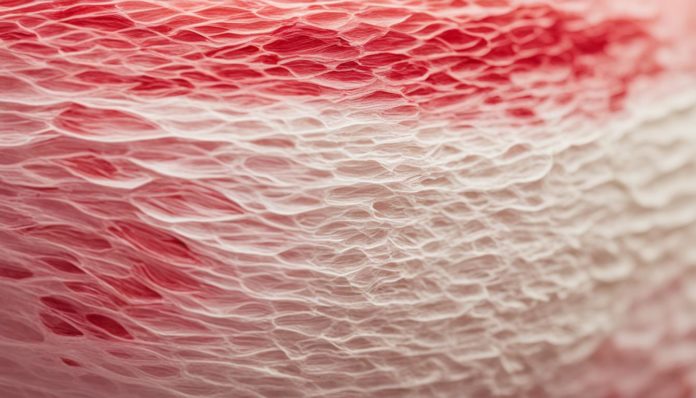Did you know nearly 10% of adults will face intertrigo at some point? This skin condition can be uncomfortable and stubborn if ignored. This guide will cover the main symptoms of intertrigo, share skin care advice, and discuss ways to handle it. Recognizing it early and acting fast can greatly ease the pain and stop more problems.
Key Takeaways
- Intertrigo is an inflammatory skin condition affecting about 10% of adults.
- Symptoms include redness, itching, and irritation in skin folds.
- Proper skin care tips can help manage and prevent intertrigo.
- Early diagnosis and intervention are crucial for effective management.
- Daily hygiene and appropriate clothing choices are essential to prevent flare-ups.
What is Intertrigo?
Intertrigo is a skin problem that happens when skin rubs against skin. It causes swelling, redness, and irritation. Knowing what it is and where it happens is key to manage and stop it.
Definition and Overview
Intertrigo is specifically caused by friction between skin and moisture. This friction can break down the skin’s protection. This makes it easy for bacteria, fungi, or yeast infections to start. People with Intertrigo often feel discomfort, itching, and burning.

Common Affected Areas
Intertrigo usually happens in places where skin touches skin a lot. These places are:
- Underarm folds
- Groin area
- Under the breasts
- Between fingers and toes
- Abdominal folds
Knowing where Intertrigo can occur is important. It helps catch it early and treat it, avoiding further discomfort and issues.
Causes of Intertrigo
Intertrigo is a skin problem caused by many factors. Skin rubbing together causes irritation and can lead to infection. Knowing what causes Intertrigo helps in treating and preventing it.
Environmental Factors
Heat, humidity, and friction are major environmental causes of Intertrigo. These conditions make a perfect spot for yeast and bacteria to grow. During hot months, the situation worsens due to high temperatures and sweat.
Tight clothes and repeated movements increase skin-on-skin rubbing. This makes the irritation even worse.

Health Conditions
Several health issues can raise the chance of getting Intertrigo. Being overweight leads to more skin folds, such as in the groin or under the arms. Diabetes impacts the skin and lowers infection resistance.
People with weak immune systems or skin problems like eczema are at greater risk. Their skin protection is not strong.
| Cause | Description |
|---|---|
| Heat and Humidity | Creates a moist environment conducive to yeast and bacterial growth. |
| Friction | Skin-on-skin contact leading to irritation and inflammation. |
| Obesity | Increases skin folds, heightening the risk of Intertrigo. |
| Diabetes | Compromises skin integrity and hinders infection control. |
Knowing these causes helps people take steps to lower their risk. It helps manage the condition if it happens.
Recognizing Intertrigo Symptoms
It’s important to know the early signs of Intertrigo for quick treatment. Skin redness in areas like under the breasts or groin is a key symptom. Seeing a rash or skin breakdown, along with itching or burning, is common.
- Moist, soft, or gummy skin texture
- A foul smell due to bacterial or yeast infections complicating the condition
- Discomfort or pain in affected areas
Knowing if you have Intertrigo is key to avoiding worse problems, like infections. It’s different from conditions like eczema or psoriasis, so treatment varies.
Here’s a brief guide to spot Intertrigo symptoms:
| Symptom | Intertrigo | Other Conditions |
|---|---|---|
| Redness | Present in skin folds | May be widespread |
| Skin Breakdown | Common | Less Common |
| Moisture | Significant | Variable |
| Odor | Often present | Rare |
Spotting these signs early can lead to a quicker and more successful treatment of Intertrigo.
Intertrigo: Diagnosis and When to See a Doctor
It’s very important to diagnose Intertrigo early and get the right medical advice. This skin issue needs proper care to avoid worse problems. Let’s talk about how doctors figure out if you have Intertrigo and when you should see one.
Diagnostic Procedures
A doctor will first look closely at your skin to start diagnosing Intertrigo. They check for signs like redness, swelling, or sores. This helps them see if it’s Intertrigo or something else. Sometimes, they need to do more tests such as:
- Skin Scrapings: Looking at skin samples under a microscope helps find infections.
- Wood’s Lamp Examination: A special light shows if there are bacteria or fungi on the skin.
- Patch Testing: This finds allergies that might make Intertrigo worse.
Thoroughly checking for Intertrigo helps doctors make the best plan for you. This means you can get better faster and avoid more issues.
Signs That Warrant Medical Attention
Knowing when to get help for Intertrigo is crucial. There are certain things to watch for. If you see any of these, it’s time to talk to a doctor:
- Severe Redness and Swelling: Very red or swollen skin could mean the infection is getting worse.
- Persistent Itching or Pain: If the itching or pain won’t go away, you might need a doctor’s help.
- Drainage or Odor: Bad smell or stuff coming out of the skin usually means a serious infection.
Seeing these signs? Don’t wait. Getting medical advice early helps you manage Intertrigo better and keeps your skin healthy.
Effective Intertrigo Treatment Options
Finding the right treatment for Intertrigo is key for comfort and skin health. There are many treatments you can choose from. Some are over-the-counter, while others are prescription meds. Your choice should be based on how severe your Intertrigo is. Let’s look at some of the best treatments around.
Over-the-Counter Remedies
For mild Intertrigo, over-the-counter remedies can really help. These treatments are easy to get and often work well early on. You can find antifungal creams and powders, they keep your skin dry and fight off yeast or bacteria.
- Antifungal Creams: Try Clotrimazole or Miconazole for fungus issues.
- MediPads: Medicated pads with calamine or zinc oxide can calm your skin.
- Absorbent Powders: Powders based on cornstarch are great for drying the skin.
Prescription Treatments
If your Intertrigo is tough, you might need prescription treatments. These are stronger and help when over-the-counter options don’t do enough.
- Topical Steroids: For inflammation, doctors may suggest steroids like Hydrocortisone.
- Oral Antibiotics: Bad infections could need antibiotics.
- Prescription Antifungals: For hard-to-beat fungal issues, drugs like Ketoconazole or Fluconazole are used.
Knowing your options for treating Intertrigo helps you manage symptoms better. Whether you pick over-the-counter or prescription treatments, talk to a doctor to find what’s best for you.
Daily Tips for Intertrigo Prevention
Preventing Intertrigo requires daily care, focusing on cleanliness and the right kind of clothes. Here are some useful tips to prevent Intertrigo.
Personal Hygiene
Keeping clean is key to avoiding Intertrigo. It’s vital to wash and dry affected areas well. This approach is the cornerstone of prevention.
Wash daily with a gentle soap and dry off properly. This helps control moisture, which causes Intertrigo.
- Wash the Skin Gently: Use a mild, non-irritating soap.
- Dry Thoroughly: Make sure to pat the skin dry, specially in skin folds.
- Maintain Moisture Balance: A bit of talcum powder can keep the skin dry.
Clothing and Fabrics
The right clothes matter a lot too. Wear items that let your skin breathe and don’t rub the wrong way.
- Wear Breathable Fabrics: Cotton or fabrics that wick away moisture are best.
- Avoid Tight Clothing: Clothes that fit loosely are better to cut down on rubbing.
- Change Damp Clothing Promptly: Get out of wet clothes fast to keep skin dry.
Following these tips and keeping up with hygiene can really lower your chances of getting Intertrigo. Pick the right clothes to protect your skin from irritation.
Managing Intertrigo Rash
For effective Intertrigo rash management, it’s important to combine prevention with treatment. This approach eases discomfort and helps heal the skin. It’s especially vital for areas that stay moist and rub together.
Keeping the area clean and dry is key to treating Intertrigo rash. Wash gently with mild soap and water. Make sure to dry well to prevent fungus and bacteria growth. A fan or cool air dryer helps dry without irritation.
Topical treatments play a big role in managing Intertrigo. Use barrier creams or ointments, like zinc oxide or petroleum jelly. They protect against friction and moisture. For infections, antifungal or antibacterial powders and creams work well. Always follow your healthcare provider’s advice for best results and safety.
For deeper understanding of Intertrigo and its management, check out the Cleveland Clinic.
Innovative solutions like breathable fabric patches or moisture-wicking clothing help, too. They lower friction and keep skin dry to avoid irritation. Also, managing weight and diabetes can reduce Intertrigo flare-ups.
| Management Strategy | Benefit |
|---|---|
| Cleaning and drying | Reduces fungal and bacterial growth |
| Topical treatments | Protects skin and treats infections |
| Innovative solutions | Keeps skin dry and reduces friction |
| Lifestyle adjustments | Prevents recurrence and improves overall health |
Reaching the best Intertrigo rash management involves regular, focused care. Mix old methods with new technology for effective treatment and prevention of Intertrigo.
Natural Remedies for Intertrigo
Exploring natural remedies for Intertrigo can help manage and prevent this skin condition. Many choose home and herbal remedies to lessen discomfort and heal. These methods are effective and alternative.
Home Treatments
Simple home treatments can quickly ease Intertrigo symptoms and speed up healing. Keeping the affected areas dry and clean is crucial. Applying cool compresses can lessen inflammation.
Use anti-fungal powders available over the counter. Regularly wash with gentle soap and water, and dry carefully. This stops the bacterial growth that often makes symptoms worse.
Herbal Solutions
Herbal remedies use natural ingredients to fight Intertrigo. Tea tree oil, with anti-fungal and anti-inflammatory effects, can be used diluted. Aloe vera gel soothes and heals when used often.
Calendula cream is also effective in reducing irritation and helping skin repair. These herbal solutions are powerful in treating Intertrigo.
| Remedy | Properties | Application |
|---|---|---|
| Tea Tree Oil | Anti-fungal, Anti-inflammatory | Apply diluted solution |
| Aloe Vera Gel | Soothing, Healing | Apply directly to skin |
| Calendula Cream | Anti-inflammatory, Healing | Apply gently to affected area |
Choosing home or herbal treatments for Intertrigo means focusing on holistic care. These natural options offer gentle yet effective ways to alleviate discomfort and enhance skin health.
Conclusion
We’ve learned a lot about Intertrigo, including what it is and how to manage it. Taking care of your skin is key. We covered everything from the basics to how it’s caused, its symptoms, and ways to treat it. It’s clear that things like your environment and other health issues can make this rash worse.
Knowing the signs of Intertrigo and getting help early are vital. There are many treatment options available, from store-bought to prescriptions. Also, simple things like keeping clean and wearing the right clothes can keep it from coming back.
It’s important to look at the whole picture when treating Intertrigo. Making small changes in your life and using natural remedies can do more than just treat it; they can prevent it. This guide hopes to help you care for your skin better. By keeping informed and careful, you can avoid this issue and keep your skin healthy.
FAQ
What are the main symptoms of Intertrigo?
Intertrigo causes redness, itching, and a rash in places where skin touches skin. It can lead to skin breakdown. Untreated, it might cause infections.
Which areas of the body are commonly affected by Intertrigo?
The areas often affected are under the breasts, the armpits, and the groin. It also appears between the toes and elsewhere skin rubs together.
What environmental factors contribute to Intertrigo?
Heat, humidity, and friction make the perfect storm for Intertrigo. They raise skin moisture and warmth, causing irritation.
What health conditions can predispose someone to Intertrigo?
Conditions like obesity, diabetes, and too much sweating can increase risk. They lead to more skin folds and moisture.
How is Intertrigo diagnosed?
Doctors usually diagnose it by looking. Sometimes, lab tests are needed to check for infections.
What over-the-counter remedies are available for Intertrigo?
For Intertrigo, you can use antifungal creams, antibacterial ointments, and barrier creams. They protect and reduce skin irritation.
When should one seek medical attention for Intertrigo?
See a doctor if home treatments don’t work or if there’s infection signs. These include increased redness, swelling, or pus.
What daily tips can help prevent Intertrigo?
To prevent Intertrigo, stay clean and dry, especially in skin folds. Wear clothes that breathe and avoid tight ones. Change wet clothes quickly.
Are there any natural remedies for managing Intertrigo?
Natural remedies like coconut oil, aloe vera, or diluted tea tree oil can help. But, talk to a healthcare provider before trying them.
What are some effective treatment options for Intertrigo?
Keep affected skin dry and clean, use doctor-recommended medicine, and follow care tips. This helps treat Intertrigo and stops it from coming back.


